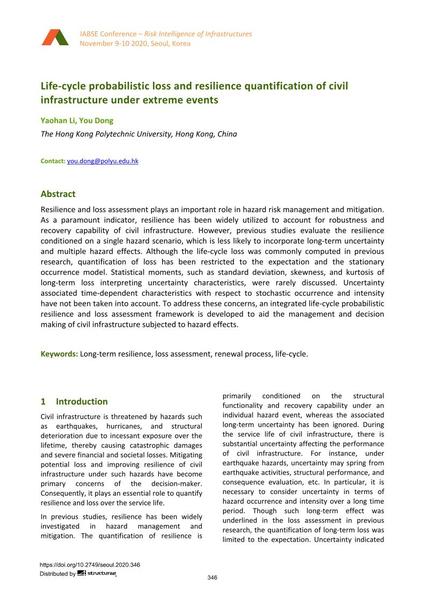Life-cycle probabilistic loss and resilience quantification of civil infrastructure under extreme events

|
|
|||||||||||
Détails bibliographiques
| Auteur(s): |
Yaohan Li
(The Hong Kong Polytechnic University, Hong Kong, China)
You Dong (The Hong Kong Polytechnic University, Hong Kong, China) |
||||
|---|---|---|---|---|---|
| Médium: | papier de conférence | ||||
| Langue(s): | anglais | ||||
| Conférence: | IABSE Conference: Risk Intelligence of Infrastructures, Seoul, South Korea, 9-10 November 2020 | ||||
| Publié dans: | IABSE Conference Seoul 2020 | ||||
|
|||||
| Page(s): | 346-352 | ||||
| Nombre total de pages (du PDF): | 7 | ||||
| DOI: | 10.2749/seoul.2020.346 | ||||
| Abstrait: |
Resilience and loss assessment plays an important role in hazard risk management and mitigation. As a paramount indicator, resilience has been widely utilized to account for robustness and recovery capability of civil infrastructure. However, previous studies evaluate the resilience conditioned on a single hazard scenario, which is less likely to incorporate long-term uncertainty and multiple hazard effects. Although the life-cycle loss was commonly computed in previous research, quantification of loss has been restricted to the expectation and the stationary occurrence model. Statistical moments, such as standard deviation, skewness, and kurtosis of long-term loss interpreting uncertainty characteristics, were rarely discussed. Uncertainty associated time-dependent characteristics with respect to stochastic occurrence and intensity have not been taken into account. To address these concerns, an integrated life-cycle probabilistic resilience and loss assessment framework is developed to aid the management and decision making of civil infrastructure subjected to hazard effects. |
||||
